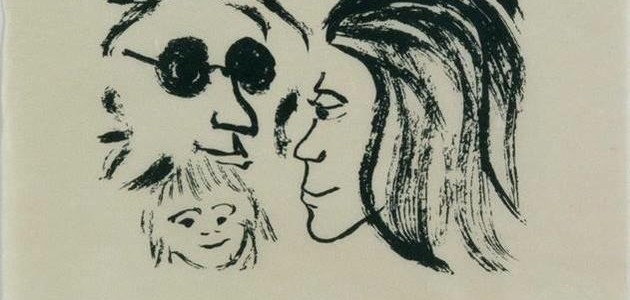5280 [The Denver Magazine] A Conversation With: Yoko Ono
So you think Yoko Ono broke up the Beatles. Rest assured, this might be the least original thought you’ll have this decade. The iconic nature of Ono and John Lennon’s relationship has transcended global fame, tragedy, and even time. Their relationship and its idiosyncrasies are depicted in the Artwork of John Lennon, a collection of prints adapted by Ono from Lennon’s originals, which will be on display at Fascination St. Fine Art from June 5 to 7. This nomadic art show reveals Lennon’s first (and lesser known) love: visual art. With approximately 70 limited edition prints spanning from 1969 through Lennon’s tragic assassination in 1980, this show pays homage to the multidimensional artist. Each print reproduction in the show, which has visited cities in five continents over the last 20 years, was guided, approved, and hand-signed by Ono.
We spoke with Ono by phone to understand her motivation for adapting her late husband’s whimsical and poetic drawings, and to understand the experiences that colored his tender, satirical, and optimistic depictions of their all-too-brief time together.
5280: What motivated you to adapt John’s work into print form?
Yoko Ono: I always remember how John felt about it. John always wanted to do an exhibition of his work, but I was very difficult to do. You wouldn’t believe it. In those days, no one thought you should have two jobs, as an artist and a musician. I just couldn’t find a place where they would do John’s show unless, they say, you’re coming. So I did go to many. Now I don’t have to go because they really understand John’s works. For me to be there is almost a distraction for them. It’s good that people really go to the show because they love John and they love John’s work.
Is there a piece in the show that represents a particularly fond memory you have with John?
There’s a very, very personal one. Because I was an artist, I thought that something erotic would not upset me or surprise me. But then I realized when giving that work to a big crowd of people, the general public, there’s a question about it. But now, I don’t regret it. In terms of which one I like, well I’m hands-on about selecting the pieces to go to the show. The reason why I do this is because I really love them. I’m not saying something politically correct, I just really love John’s work, but I also know he’s a good, good artist. The kinds of lines that he uses are really very professional.
Why is it important that people understand the multidimensionality of his artistic life?
He did not hesitate to show his talent in these two fields, because he just loved it. He loved making music and he loved making art. I think that he was doing all these things, even when he was a teenager and the stuff that I saw from when he was a teenager it was really like a professional adult. I was amazed, and the subject matter was very political and satirical. How was a teenager doing this? The stuff that he started to do when I was with him, he was very happy about the family situation. But also he visited Japan with me, and with the Beatles, too. But this time because of being with me, he really tuned into the Japanese way of doing things.
What was John’s creative process?
His creative process was very much like what he did with music. Whenever he thought of a song he would just write it down, even on the plane—he just did it. That’s how it was with his drawings. There was no planning. He just did it. He didn’t have any kind of way saying, this is how you have to do it. He was a very free soul.
Many of the pieces convey the strong bond between you and John. What was it that made your love so unique?
We were very lucky. We didn’t think it was going to happen that way. Both of us were kind of cynical by then. We met and seemed to work so well, so easily, and we couldn’t believe it. When he came to the gallery at the first meeting, I was doing a show at the gallery, he just sort of appeared. No one told me it was this or that. I was really deep in the art world and I didn’t know about rock and roll. He was sort of putting a bite in an apple, and I didn’t particularly like it. When he left, all these students from St. Martins Art School, they were assisting me. They said, ‘Is that John Lennon? I think that was John Lennon, the Beatle.’ I said, ‘Really?’ I didn’t know the name John Lennon was supposed to be in the Beatles.’ That was all I thought. That was the first meeting and then after that, we had all sorts of ups and downs, but mostly ups.
As you see it, is there an important social or cultural message conveyed by this body of work?
The kind of work that you will see in the gallery show is very important because there’s no violence, no being extremely mean. He was doing something that shows the humanity of people and with a sense of humor. That’s very rare these days, because you don’t get to buy things unless they’re spotless. He wasn’t concerned if is this was going to sell. He just did it. I think that’s very artistic and beautiful. That’s very rare these days. It’s a very financial world we live in. He didn’t think that way; he just did it. It’s going to make you feel. This world peace is possible.
He might have done more things if he had lived longer. It’s very sad. He was 40— that’s very young, don’t you think? I wish John had had more time.
What would you want viewers of the show to know to enhance their understanding or enjoyment of the works?
I want everybody to have their own judgment and understanding. That’s all you can expect from people, but not really. People think, ‘What am I supposed to think? What do the critics think?’ I want people to form their own thoughts and reactions. You’re going to get his power, and his belief in truth. He always thought that we had to be truthful. And that’s going to come through I think.
Have you ever been to Denver?
I have. There’s certain quietness about it, and yet still it’s a city. Keep it up. I liked it. Many beautiful restaurants, and it was great.
The exhibition is free and open to the public. Proceeds from the suggested $5 donation will benefit Food Bank of the Rockies. Fri 6-9 p.m.; Sat-Sun noon-5 p.m. Fascination St. Fine Art, 315 Detroit St., 303-333-1566


Comments are closed.